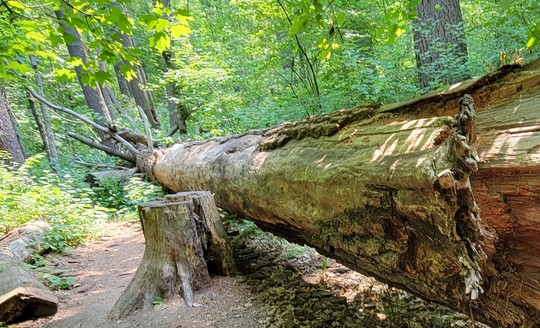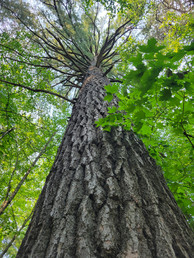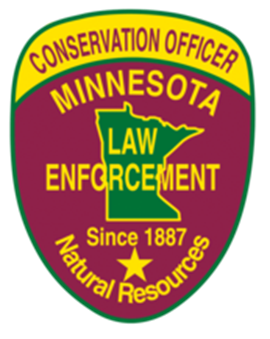Lost 40 SNA highlighted in National Geographic
 Photo credit: Amelie Hyams
The Lost 40 Scientific and Natural Area was featured in a recent article for the National Geographic Magazine: "This 1882 surveying error saved a patch of forest from logging."
The error the headline mentions was done during the public land survey of 1882. The pines of the Lost 40 SNA were missed by loggers because surveyors mistakenly mapped the area as Coddington Lake (the lake is located a half-mile to the southeast).
The error was fixed when the site was re-surveyed in 1960 and shortly after, the site was incorporated into Big Fork State Forest. The SNA features 32 acres of old-growth white pine and red pine forest.
Check out this excerpt from the article:
----------

Today, the Lost 40 is surrounded by trees once again—though the trees of the Lost 40 are often more than twice or three times as old as the surrounding forest.
Despite the old age of the Lost 40’s pines, their grandeur is subtle. (DNR plant ecologist AmberBeth) VanNingen tells visitors not to expect California redwoods. “We’re in the middle of the continent. It’s cold here, especially in the winter. It’s also dry here,” she says. For that reason, she says, Minnesota’s trees don’t grow at the same rate or live as long as those on the coasts. But many of the trees are objectively massive specimens. The Lost 40 is home to the state’s largest living red pine, which stands at 120 feet tall and nearly 10 feet around.
The Lost 40’s undisturbed, old-growth trees have benefits beyond just their awesome size. Certain animal species—including some woodpeckers, who find more suitable and plentiful insects in older trees—are much more abundant in the Lost 40 than in other parts of Minnesota.
“It’s the right mixture of a lot of different things—between the big trees and also the amount of dead and decaying trees,” says Arika Preas, a naturalist with the Minnesota Department of Natural Resources. That biodiverse and complex habitat makes the Lost 40 a destination for birdwatchers. “It takes time to get that complexity,” Preas adds.
|
----------
Read the full article on the National Geographic website.
NOTE: The National Geographic website requires an account to view articles, which grants access to three free stories per month.

Lake litter, unsafe ice, snowmobile fires, and more
Editor's note: Every Monday, DNR conservation officers document how they spent the previous week and highlight some of the most important issues in their areas. The Enforcement Division posts these weekly reports and sends them to media outlets and other people who sign up to receive them. This Spotlight feature highlights a few of those reports in the first issue of the month.
Anglers continue hitting lakes throughout the state, though slush is making travel difficult in some areas. The snowmobile season also is in full swing, with excellent conditions in many parts of the state.

Jan. 24
CO Nicholas Prachar (Blackduck North) worked angling activity on and near Upper Red Lake. Numerous complaints were fielded about people with “RV” style wheelhouses who dump sewage on the ice when they leave the lake. One contact was made with a suspect. Enforcement action was taken for litter, angling with extra lines, and possession of a controlled substance.
CO Bret Grundmeier (Hinckley) reported a few more lakes in the Hinckley area saw pickups and wheel house traffic for the first time of the winter. Despite the improved ice conditions, a vehicle and a person on foot broke through the ice. The two incidents were good reminders that no matter how cold the weather or how late in the winter, always check the ice prior to traveling on lakes.
CO Matt Loftness (Marshall) checked on one happy ice angler who had just retrieved his cell phone from the bottom of the lake by snagging it with a hook after locating it with a fish camera. To top it off, he was able to turn it on and pull up his online angling license.
|
Jan. 31
CO Taylor Hochstein (Hill City) responded to a call of a snowmobile that was on fire on the trail. Nobody was injured, but the snowmobile had been torched so badly that it hardly resembled a snowmobile anymore. The only thing that was recognizable was a frozen pizza that the operator was carrying on the back of the snowmobile.
CO Tou Vang (Pierz) and CO Stephen Westby assisted with escorting and welcoming our brave men and women of the 1-194th Armor Regiment of the Minnesota National Gard home from their deployment overseas.
CO Mike Krauel (Mora) spent the week checking snowmobiles and patrolling for angling activity. Krauel also assisted a neighboring officer on a stop of a snowmobile with expired registration operating in the median of a divided highway. The operator stated he was unaware he could not operate in the median and also stated he had not taken the required DNR snowmobile safety training. If the operator had taken the required safety training, he would have learned about registration and the correct places to operate a snowmobile.
Meet your Organizational Health Team
"We Excel at helping you Access resources to take Ctrl and Shift our workplace culture!"
-
Did you know that there is a staff work team at the DNR dedicated to workplace culture, respect, and health?
-
Did you know that this team may be a resource for you on organizational health issues you care about?
-
Did you know that there may be opportunities to bring your talents and passion to aid the work of the team?
If not, meet the Organizational Health Team!
What is the Organizational Health Team?
The OHT was established in late 2019 to help support a workplace culture that is inclusive, respectful, and healthy; enhance the DNR’s ability to serve all Minnesotans by cultivating a highly qualified workforce that reflects and embraces diversity of Minnesota's population; and promote department-wide coordination and cooperation. The OHT also provides leadership to advance the DNR strategic priorities, primarily:
- Expand diversity, equity, and inclusion
- Cultivate a healthy, supportive, and safe workplace
The team works on issues at the agency level, and is available to help support initiatives at the regional or divisional level as well.
Who is the OHT?
The OHT was formed by bringing together several teams that you are probably already familiar with:
- Continuous Improvement
- Culture of Respect
- Diversity, Equity, and Inclusion
- Organizational Learning and Professional Development
- Wellbeing
The intent of bringing these groups under “one roof” was to enhance coordination and efficiency, and identify and build on areas of alignment. The OHT includes a champion, chair, representative members, ex officio members, subject matter experts, and staff support.
How can you be involved?
I know! This all sounds very exciting, and you are ready to do your part to build a more healthy, inclusive and respectful workplace. If you are working on an organizational health issue within your region, division, or program, you are encouraged to reach out to members of the OHT (listed below) to seek support and coordination with agency initiatives. We also have upcoming opportunities to join OHT action teams. Specifically, we will soon be recruiting members for Wellness and DEI action teams, so please keep any eye out for that notification. If you have questions about the OHT team please contact your representative member:
|
ENF: Adam Block
EWR: Jake Walsh
FAW: Michaela Rice
|
OSD: Jean Dolensek
PAT: Melody Webb
Region 1: Open
|
|
FOR: Bob Milne
LAM: Jennifer Engstrom
MNIT: Catherine Hansen
|
Region 2: Lisa Angelos
Region 3: Laurel Quill
Region 4: Brooke Hacker
|
Managers and supervisors: register for
required Safety Leadership Training

FY2022 Safety Leadership Training sessions for managers and supervisors are going to be
March 22 and 24, and May 17 and 19. Each session is two days. Please complete module one and two on ELM before you attend the sessions (which is module three). Safety Leadership Training is required for all managers and supervisors. If you haven't taken it yet, register for the sessions using ELM.
To register, enter the class codes:
-
Module 1: R29DNRMRGLST511A
-
Module 2: R29DNRMRGLST521A
-
Module 3: R29DNRMRGLST531A
If you have any questions, contact Maelene Rhodes.
|
Sally Dybdal named 2021 Procurement Professional of the Year
Sally Dybdal, purchasing director within the Office of Management and Budget Services, has been awarded the 2021 Procurement Professional of the Year Award from the Minnesota Chapter of the National Institute of Governmental Purchasing.
Minnesota NIGP is a professional association dedicated to promoting professionalism in procurement and contract for public entities throughout the state. Minnesota NIGP awards its Procurement Professional of the Year Award based on contributions and accomplishments in the area of purchasing, service to their employer, NIGP involvement at state and national levels, and professional development in the area of purchasing.
Dybdal received the award based on her many notable contributions to the DNR in 2020 and 2021, including:
- Leadership in creating a “COVID supplies” site within the DNR warehouse to allow employees to get COVID supplies quickly.
- Assistance for the Enforcement Division as they responded to multiple public safety related events.
- Contributions to the Electronic Process Conversion Team as they converted numerous processes from a paper and manual workflow to electronic processes.
Dybdal was also recognized for her leadership as the Minnesota NIGP board nomination chair and her continued support of DNR purchasing staff in their professional growth and development.
Congratulations!
Letter from a former DNR employee
NOTE: This is an excerpt from a letter sent to DNR Wildlife Lake Specialist Maggie Gross from former DNR employee Dennis Hanson about the updated Heron Lake Management Plan. Hanson wrote the original 1972 management plan for Lake Heron. The letter has been lightly edited.
"Your Heron Lake Management Plan appears to be a complete assemblage of wildlife management objectives, which I rather quickly reviewed from the internet on DNR news. You are to be congratulated for your thoroughness and long-time persistence. It surprised me as I never did expect to be reading it 49 years after the first.
...
In the late 60s and early 70s, there was a push by the Minnesota Waterfowl Association to get going on lake designation, so I tried Heron and Pierce lakes. The survey of vegetation and depth was done by Roy Nelson and myself, who also helped on Pierce, using manual methods of the era — no electronics, just pencils, paper, a Secchi disc, and a boat. Drew lake maps using ASCS aerial photos using real ink on a vollum map paper like we used to draw up proposed wildlife areas. In those days, we actually did land appraisals, negotiated and used a portable typewriter for typing the 'option to purchase.'"

Region 4 Facilities Advisor Dennis Smith
 Dennis Smith and his family.
Maintaining buildings, protecting the environment
behind the scenes
By Maggie Snyder, news release and media specialist
After 25 years at the Minnesota Department of Transportation, Dennis Smith wasn’t sure if he was going to accept the Region 4 facilities advisor position the DNR offered him.
Smith liked his job with MnDOT, after all, and the commute allowed him to spend more time with his family. However, the DNR job would allow him to leave his toolbelt at home and manage a crew – so he decided to accept and he joined the DNR in May 2018. He’s glad he did, Smith said.
“I came so close to not taking this job and I’m so grateful I did, because it’s amazing people I work with,” he said. “We truly work as a team.”
Smith began working in construction when he was 13 years old, working summers and weekends for a neighbor who was a concrete contractor. He did that work until he graduated high school, when he got experience with a variety of trades before moving to MnDOT.
At the DNR, Smith and two others manage 456 buildings at 29 different sites. Smith is also helping to inventory the DNR’s septic systems. The DNR has many rural sites, many of which use septic systems and a drain field to treat wastewater. These systems were installed decades ago and information about them has been lost over time.
It’s important to find these systems and get a handle on their condition because they can be expensive to replace and can contaminate the environment if they fail, Smith said.
“We are the entity that the state has given us a charge to protect our natural resources,” he said. “What would it look like if we contaminated a trout stream, or a lake, or a groundwater source where a well is that provides drinking water? Not just that, but it’s the right thing to do.”
Nobody thinks about it when they flush the toilet, but making sure wastewater is filtered and treated before it’s put back into the ground is essential for maintaining a healthy environment, Smith said.
“I have five grandkids – hoping for more – but I want them to have clean water to drink,” he said. “I want them to go to state parks and enjoy their experience. We can’t do that if we’re not doing something that nobody thinks about. It takes money, and it takes time, and it takes resources, but it’s very important.”
In his free time, Smith said he likes to spend time with his kids, grandchildren, and wife of 38 years.
“For me, God is first and then family is second and in order to support those first two, I need to work,” he said. “That’s the order of importance for me for things. When I have free time, I love spending time with my family – whether it’s out building a stick fort with my grandkids or taking them to a state park or river fishing.”
 Name: Dennis Smith
Title: Region 4 facilities advisor
Joined the DNR: May 2018
Work location: New Ulm
Education: High school
Fun fact: “Since I’ve been in construction for so long, people sometimes find me intimidating. This will ruin my tough guy image, but one of the things my wife and I like to do is go to plays. I love going to plays – don’t care if it’s a high school play, college play, or something professional coming to town.”

Mississippi Headwaters in winter
 The Mississippi Headwaters at Itasca State Park after a fresh snowfall. Photo credit: Deb Rose
Editor's note: If you have a photo you like to submit for consideration for the Minnesota Moment section, please send to newsletter.dnr@state.mn.us Editor will make final decision which photos appear in this section.
|